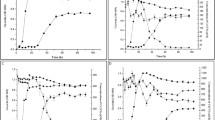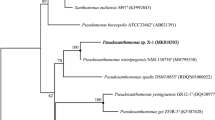Abstract
Sequencing, RFLP analyses and experiments utilizing a lacZ transcriptional reporter fused to the promoter regions of nahR and nahG in Pseudomonas putida Cg1 confirmed that regulation of naphthalene degradation in both P. putida Cg1 and the type strain, P. putida NCIB 9816-4, is consistent with that of NAH7 from P. putida G7. Two nahR knockout strains (RK1 and Cg1-NAHR from P. putida NCIB 9816-4 and Cg1, respectively) showed a growth defect in the presence of naphthalene as sole carbon and energy source. We hypothesized that nahR influences ecological fitness of bacteria in naphthalene-contaminated soil and tested this hypothesis using both parent and nahR-knockout strains introduced to soil microcosms with and without added naphthalene. After 21 days, loss of cell viability was pronounced in the presence of added naphthalene crystals for nahR mutants of both test bacteria, relative to the wild types. Diminished viable counts were attributed to toxicity. Thus, our data indicated that NahR in P. putida Cg1 is virtually identical to its homologues in other pseudomonads and that nahR is required for resistance to naphthalene toxicity, hence the persistence of bacterial cells in soil with high concentrations of naphthalene.





Similar content being viewed by others
References
Ahn IS, Ghiorse WC, Lion LW, Shuler ML (1998) Growth kinetics of Pseudomonas putida G7 on naphthalene and occurrence of naphthalene toxicity during nutrient deprivation. Biotechnol Bioeng 59:587–594
Arai H, Akahira S, Ohishi T, Maeda M, Kudo T (1998) Adaptation of Comamonas testosteroni TA441 to utilize phenol: organization and regulation of the genes involved in phenol degradation. Microbiology 144:2895–2903
Ausubel FM, Brent R, Kingston RE, Moore DD, Seidman JG, Smith JA, Struthl K (1999) Current protocols in molecular biology. Wiley, New York
Bosch R, Garcia-Valdes E, Moore ER (2000) Complete nucleotide sequence and evolutionary significance of a chromosomally encoded naphthalene-degradation lower pathway from Pseudomonas stutzeri AN10. Gene 245:65–74
Collier LS, Gaines GL III, Neidle EL (1998) Regulation of benzoate degradation in Acinetobacter sp. strain ADP1 by BenM, a LysR-type transcriptional activator. J Bacteriol 180:2493–2501
Foster PL (1999) Mechanisms of stationary phase mutation: a decade of adaptive mutation. Annu Rev Genet 33:57–88
Garcia EM, Siegert IG, Suarez P (1998) Toxicity assay and naphthalene utilization by natural bacteria selected in marine environments. Bull Environ Contam Toxicol 61:370–377
Hendrickson H, Slechta ES, Bergthorsson U, Andersson DI, Roth JR (2002) Amplification-mutagenesis: evidence that “directed” adaptive mutation and general hypermutability result from growth with a selected gene amplification. Proc Natl Acad Sci USA 99:2164–2169
Herrick JB, Madsen EL, Batt CA, Ghiorse WC (1993) Polymerase chain reaction amplification of naphthalene-catabolic and 16S rRNA gene sequences from indigenous sediment bacteria. Appl Environ Microbiol 59:687–694
Herrick JB, Stuart-Keil KG, Ghiorse WC, Madsen EL (1997) Natural horizontal transfer of a naphthalene dioxygenase gene between bacteria native to a coal-tar-contaminated field site. Appl Environ Microbiol 63:2330–2337
Hohnstock AM, Stuart-Keil KG, Kull EE, Madsen EL (2000) Naphthalene and donor cell density influence field conjugation of naphthalene catabolism plasmids. Appl Environ Microbiol 66:3088–3092
Huang JZ, Schell MA (1991) In vivo interactions of the NahR transcriptional activator with its target sequences. Inducer-mediated changes resulting in transcription activation. J Biol Chem 266:10830–10838
Jones RM, Britt-Compton B, Williams PA (2003) The naphthalene catabolic (nag) genes of Ralstonia sp. strain U2 are an operon that is regulated by NagR, a LysR-type transcriptional regulator. J Bacteriol 185:5847–5853
Kalogeraki VS, Winans SC (1997) Suicide plasmids containing promoterless reporter genes can simultaneously disrupt and create fusions to target genes of diverse bacteria. Gene 188:69–75
Kasak L, Horak R, Nurk A, Talvik K, Kivisaar M (1993) Regulation of the catechol 1,2-dioxygenase-and phenol monooxygenase-encoding pheBA operon in Pseudomonas putida PaW85. J Bacteriol 175:8038–8042
Kastner M, Breuer-Jammali M, Mahro B (1998) Impact of inoculation protocols, salinity, and pH on the degradation of polycyclic aromatic hydrocarbons (PAHs) and survival of PAH-degrading bacteria introduced into soil. Appl Environ Microbiol 64:359–362
Lessner BJ, Parales RE, Narayan S, Gibson DT (2003) Expression of the nitroarene dioxygenase genes in Comamonas sp. Strain JS765 and Acidovorax sp. Strain JS42 is induced by multiple aromatic compounds. Appl Environ Microbiol 185:3895–3904
Leveau JH, Meer JR van der (1996) The tfdR gene product can successfully take over the role of the insertion element-inactivated TfdT protein as a transcriptional activator of the tfdCDEF gene cluster, which encodes chlorocatechol degradation in Ralstonia eutropha JMP (pJP4). J Bacteriol 178:6824–6932
Leveau JH, Lindow SE (2002) Bioreporters in microbial ecology. Curr Opin Microbiol 5:259–265
Lorenzo V de, Perez-Martin J (1996) Regulatory noise in prokaryotic promoters: how bacteria learn to respond to novel environmental signals. Mol Microbiol 19:1177–1184
Madsen EL, Sinclair JL, Ghiorse WC (1991) In situ biodegradation: microbiological patterns in a contaminated aquifer. Science 252:830–833
Marshall B, Robleto EA, Wetzler R, Kulle P, Casaz P, Levy SB (2001) The adnA transcriptional factor affects persistence and spread of Pseudomonas fluorescens under natural field conditions. Appl Environ Microbiol 67:852–857
Mascher F, Moenne-Loccoz Y, Schnider-Keel U, Keel C, Haas D, Defago G (2002) Inactivation of the regulatory gene algU or gacA can affect the ability of biocontrol Pseudomonas fluorescens CHA0 to persist as culturable cells in nonsterile soil. Appl Environ Microbiol 68:2085–2088
Miller JH (1972) Experiments in molecular genetics. Cold Spring Harbor Laboratory, Cold Spring Harbor, N.Y.
Overbeek LS van, Eberl L, Givskov M, Molin S, Elsas JD van (1995) Survival of, and induced stress resistance in, carbon-starved Pseudomonas fluorescens cells residing in soil. Appl Environ Microbiol 61:4202–4208
Park W, Jeon C, Madsen EL (2002a) Interaction of NahR, a LysR-type transcriptional regulator, with the alpha subunit of RNA polymerase in the naphthalene degrading bacterium, Pseudomonas putida NCIB 9816-4. FEMS Microbiol Lett 213:159
Park W, Padmanabhan P, Padmanabhan S, Zylstra GJ, Madsen EL (2002b) nahR, encoding a lysR-type transcriptional regulator, is highly conserved among naphthalene degrading bacteria isolated from a coal-tar waste-contaminated site and in extracted community DNA. Microbiology 148:2319–2329
Park W, Jeon CO, Hohnstock-Ashe AM, Winans SC, Zylstra GJ, Madsen EL (2003) Identification and characterization of the conjugal transfer region of the pCg1 plasmid from naphthalene-degrading Pseudomonas putida Cg1. Appl Environ Microbiol 69:3263–3271
Park W, Jeon CO, Cadillo H, Derito C, Madsen EL (2004) Survival of naphthalene-degrading Pseudomonas putida NCIB 9816-4 in naphthalene-amended soils: toxicity of naphthalene and its metabolites. Appl Microbiol Biotechnol 64:429–435
Reams AB, Neidle EL (2003) Gene plasticity in Acinetobacter: new degradative capabilities acquired by the spontaneous amplification of large chromosomal segments. Mol Microbiol 47:1291–1304
Schell MA (1985) Transcriptional control of the nah and sal hydrocarbon-degradation operons by the nahR gene product. Gene 36:301–309
Schell MA (1993) Molecular biology of the LysR family of transcriptional regulators. Annu Rev Microbiol 47:597–626
Schell MA, Sukordhaman M (1989) Evidence that the transcription activator encoded by the Pseudomonas putida nahR gene is evolutionarily related to the transcription activators encoded by the Rhizobium nodD genes. J Bacteriol 171:1952–1959
Schell MA, Wender PE (1986) Identification of the nahR gene product and nucleotide sequences required for its activation of the sal operon. J Bacteriol 166:9–14
Schell MA, Brown PH, Raju S (1990) Use of saturation mutagenesis to localize probable functional domains in the NahR protein, a LysR-type transcription activator. J Biol Chem 265:3844–3850
Serdar CM, Gibson DT (1989) Studies of nucleotide sequence homology between naphthalene-utilizing strains of bacteria. Biochem Biophys Res Commun 164:772–779
Simon R, Priefer U, Puhler A (1983) A broad host-range mobilization system for in vivo genetic engineering: transposon mutagenesis in gram-negative bacteria. Bio/Technology 1:784–791
Simon MJ, Osslund TD, Saunders R, Ensley BD, Suggs S, Harcourt A, Suen WC, Cruden DL, Gibson DT, Zylstra GJ (1993) Sequences of genes encoding naphthalene dioxygenase in Pseudomonas putida strains G7 and NCIB 9816-4. Gene 127:31–37
Slauch JM, Silhavy TJ (1991) Cis-acting ompF mutations that result in OmpR-dependent constitutive expression. J Bacteriol 173:4039–4048
Stuart-Keil KG, Hohnstock AM, Drees KP, Herrick JB, Madsen EL (1998) Plasmids responsible for horizontal transfer of naphthalene catabolism genes between bacteria at a coal-tar-contaminated site are homologous to pDTG1 from Pseudomonas putida NCIB 9816-4. Appl Environ Microbiol 64:3633–3640
Veen JA van, Overbeek LS van, Elsas JD van (1997) Fate and activity of microorganisms introduced into soil. Microbiol Mol Biol Rev 61:121–135
Yen KM, Gunsalus IC (1985) Regulation of naphthalene catabolic genes of plasmid NAH7. J Bacteriol 162:1008–1013
Yen K-M, Serdar CM (1988) Genetics of naphthalene catabolism in pseudomonads. CRC Crit Rev Microbiol 15:247–268
Acknowledgements
This research was supported by National Science Foundation Grant MCB-0084175.
Author information
Authors and Affiliations
Corresponding author
Rights and permissions
About this article
Cite this article
Park, W., Madsen, E.L. Characterization in Pseudomonas putida Cg1 of nahR and its role in bacterial survival in soil. Appl Microbiol Biotechnol 66, 209–216 (2004). https://doi.org/10.1007/s00253-004-1630-6
Received:
Revised:
Accepted:
Published:
Issue Date:
DOI: https://doi.org/10.1007/s00253-004-1630-6




